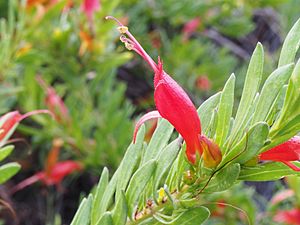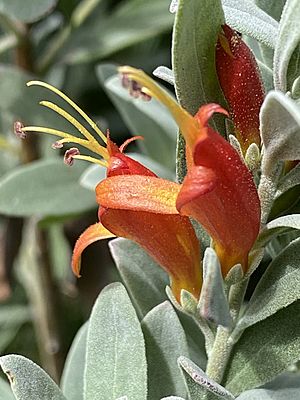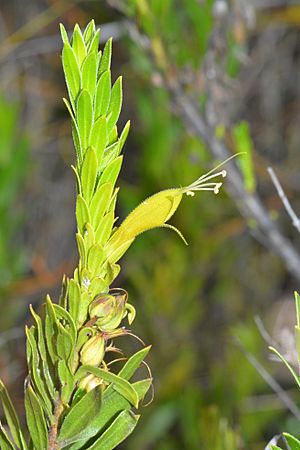Tar bush facts for kids
Quick facts for kids Tar bush |
|
|---|---|
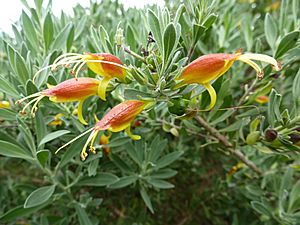 |
|
| Eremophila glabra flowers in the Mount Annan Botanic Garden | |
| Scientific classification | |
| Genus: |
Eremophila (plant)
|
| Species: |
glabra
|
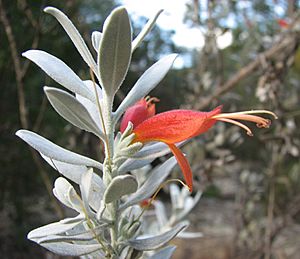
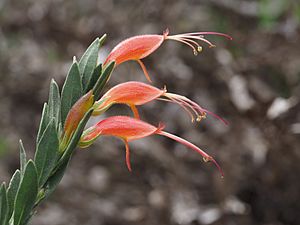
Eremophila glabra, commonly called tar bush, is a plant that belongs to the figwort family. It grows only in Australia. This plant can be a low, spreading shrub or an upright bush. Its leaves come in different sizes and shapes. The flowers also have many colours. Even though its scientific name means "smooth," not all tar bushes are hairless. Most have tiny, raised bumps called glands on their stems, leaves, and flowers.
Contents
What Does Tar Bush Look Like?
The tar bush, Eremophila glabra, can grow from about 10 centimetres (4 inches) to 3 metres (10 feet) tall. Some plants spread low on the ground, while others stand tall.
Leaves and Stems
The leaves grow one after another along the stem. Sometimes they are close together, and other times they are spread out. They are usually shaped like a spear, but can also be long and thin or egg-shaped. The leaves are about 7.5 to 61 millimetres (0.3 to 2.4 inches) long and 0.8 to 18 millimetres (0.03 to 0.7 inches) wide. They have a pointed tip and gradually get narrower towards the stem. Both the leaves and stems are covered with small, raised glands.
Flowers and Fruit
The flowers of the tar bush can be red, orange, yellow, or yellowish-green. They do not have spots. Each flower grows alone or in pairs where a leaf meets the stem, on a short stalk about 3 to 10 millimetres (0.1 to 0.4 inches) long.
Each flower has 5 sepals, which are small, leaf-like parts that protect the bud. These sepals are narrow and slightly different in length. The colourful petals are 20 to 30 millimetres (0.8 to 1.2 inches) long. They are joined together to form a tube with 5 lobes (sections) at the end. The top lobes are pointed and usually close together. The bottom lobe is blunt and bends backward. There are four stamens (the parts that produce pollen) that stick out beyond the petals.
Tar bush flowers from early autumn to summer (March to December in Australia). After flowering, it produces fruit. The fruit is oval or almost round, about 4 to 9 millimetres (0.16 to 0.35 inches) across. It is smooth, can be dry or fleshy, and is dark brown.
How Tar Bush Got Its Name
The tar bush was first officially described in 1810 by a botanist named Robert Brown. He first called it Stenochilus glaber. Later, in 1921, Carl Hansen Ostenfeld changed its name to Eremophila glabra.
The word glabra in its scientific name comes from Latin. It means "smooth" or "hairless." This might refer to the smooth, hairless part of the flower where the seeds develop.
Different Types of Tar Bush
There are many different types, or "subspecies," of Eremophila glabra. Some of these include:
- Eremophila glabra subsp. albicans
- Eremophila glabra subsp. carnosa
- Eremophila glabra subsp. chlorella
- Eremophila glabra subsp. glabra
Scientists like Andrew Brown and Bevan Buirchell have also found other types that don't have official names yet.
Where Does Tar Bush Grow?
This plant grows in all the mainland states of Australia. The most common type, Eremophila glabra subsp. glabra, is found in many different kinds of soil and plant areas. However, it usually grows in the drier parts of Australia.
Is Tar Bush Endangered?
Overall, the tar bush species is not considered to be in danger. However, one specific type, Eremophila glabra subsp. chlorella, is listed as "Threatened" by the Western Australian government. This means it is rare and needs special protection to survive.
Growing Tar Bush in Your Garden
Tar bush is a very popular plant for gardens, especially those with native Australian plants. It's great because it comes in so many different forms. You can plant several types in one garden, and they will all look unique!
Most tar bush plants are easy to care for. They don't need much work, just some water now and then and a little trim. It's hard to grow them from seeds, but you can easily grow new plants from cuttings. This way, the new plant will be just like the parent plant.
Tar bush can grow in most types of soil. It also does well in many different spots, from full sun to full shade. Most types can handle dry weather and even some frost. However, a few types with hairy leaves don't like very humid (moist) air.
Many special types of tar bush have been created for gardens. For example, "Kalbarri Carpet" is a yellow-flowered type that spreads low on the ground. "Murchison Magic" has silvery leaves and red flowers.


